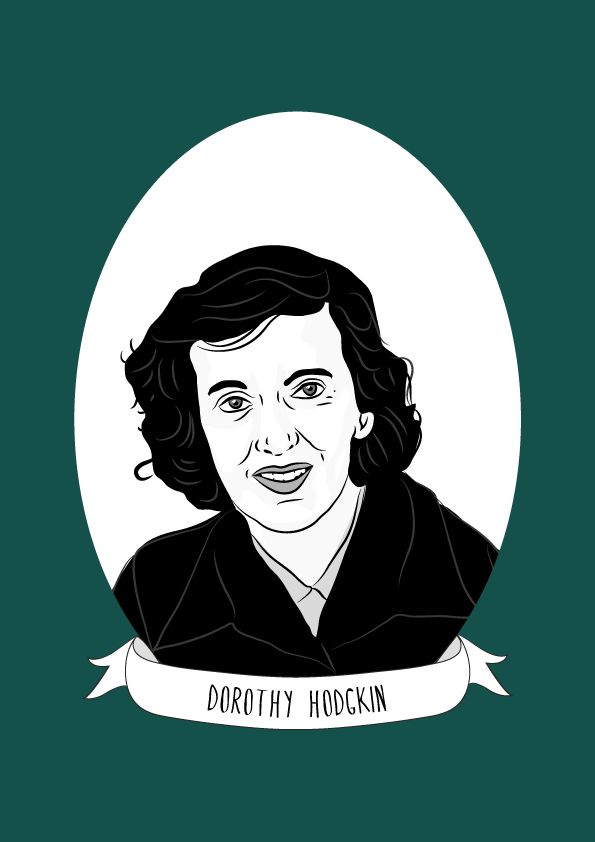Dorothy Hodgkin OM FRS was a British biochemist who developed protein crystallography. She won the Nobel Prize in Chemistry in 1964 for her determination of the structure of penicillin and vitamin B12. She is one of the pioneering scientists who worked in the field of X-ray crystallography studies of biomolecules.
Hodgkin was born in 1910 in Cairo, Egypt to father John Winter Crowfoot, an archaeologist and classical scholar, and mother Grace Mary Crowfoot, an archaeologist and expert on Ancient Egyptian textiles. Hodgkin lived in an English expatriate community in Egypt, and would return to England for a few months a year. On one of Hodgkin’s visits to England, World War I began and she was left in the care of relatives and friends while her parents returned to Egypt. At the end of the war, Hodgkin’s mother returned to England, giving Hodgkin what she described as the happiest year of her life.
At the age of 10, Hodgkin began what would become a lifelong interest in crystals, encouraged by her mother and Dr. A.F. Joseph, a friend of her parents in the who gave her chemicals and helped her to analyse ilmenite. Hodgkin would also use a portable mineral analysis kit to analyze pebbles that she and her sister found in the stream running through the family garden in Khartoum, Sudan. Hodgkin’s formal education was undertaken at the the Sir John Leman School Beccles, Suffolk. She had to fight to be allowed to study science along with the boys and as a result, was one of only two girls allowed to join learn chemistry. Hodgkin was not provided with any knowledge of Latin or further science subject and so, had to fill the gaps in her knowledge with a private tutor. Hodgkin was then able to enter the University of Oxford entrance exam, and at the age of 18, she began studying chemistry at Somerville College, Oxford. In 1932, she became the third woman to ever achieve a first-class honours degrees from Oxford University. During her studied, she was advised to research X-ray crystallography and worked with M. Powell, as his first research student on thallium dialkyl halides. She was one of the first to study the structure of an organic compound by using X-ray crystallography.
Hodgkin continued her education at the University of Cambridge, studying for a Doctor of Philosophy under the supervision of John Desmond Bernal. Hodgkin had heard Bernal lecture of metals at Oxford, and this, coupled with the fact that he was now focusing on sterols had made her take the position. Hodgkin and Bernal collaborated on using X-ray crystallography to determine the three-dimensional structure of several complex organic molecules important to the functioning of living organisms. The first of these experiments was in the analysis of a biological substance, pepsin, for which Hodgkin was awarded the majority of the credit.
In 1934, Hodgkin returned to Somerville College after being awarded a research fellowship. Two years later, she became the first fellow and tutor in Chemistry, and would hold the post until 1977. In 1937, Hodgkin married 1937 she married the left-wing historian Thomas Hodgkin, and two years later she was awarded with her Ph.D from Cambridge. In 1945, Hodgkin and C.H Carlisle published their work on the structure of a steroid. That same year, she and her colleagues determined the structure of penicillin, demonstrating that it contains a β-lactam ring. In 1948, Hodgkin began working with vitamin B12. which had been discovered by Merck earlier in the year.
vitamin B12 was composed of an almost entirely unknown structure. Hodgkin was the first to discover that it contained cobalt, which allowed her to determine the structure actualisation by x-ray crystallography analysis. The structure of B12 was published in 1955, and led to Hodgkin becoming the third woman ever to win the Nobel Prize in Chemisty in 1964 (after Marie Curie and Irène Joliot-Curie) “for her determinations by X-ray techniques of the structures of important biochemical substances.” A year later, she was made a member of the Order of Merit, Britain’s highest honour for achievement in science, the arts, and public life.
In 1960, Hodgkin was appointed the Royal Society’s Wolfson Research Professor, a position she held until 1970. This position provided her with the financial support she needed to continue her work at the University of Oxford. In 1969, 34 years after she had taken her first X-ray photograph of an insulin crystal, Hodgkin finally discovered its structure. She then worked with other laboratories dealing with research into insulin and travelled the world giving talks about insulin and its importance in diabetes.
In addition to her scientific research, Hodgkin was also passionate about social inequality and stopping conflict. From 1976 to 1988 she was President of Pugwash, an international organization that brings together scholars and public figures to work toward reducing the danger of armed conflict and to seek solutions to global security threats.
Hodgkin achieved so much in science despite the fact that from the age of 24, she began to develop chronic rheumatoid arthritis which left her hands swollen and painful. She is the only woman to received the Copley Medal, a Fellow of the Royal Society, a winner of theLenin Peace Prize, and was Chancellor of Bristol University from 1970 to 1988. She was awarded an Honorary Degree (Doctor of Science) from the University of Bath in 1978. In 1958, she was elected a Foreign Honorary Member of the American Academy of Arts and Sciences. From 1970 – 1988, she held the honorary post of chancellor of the University of Bristol, where she fought for improved education funding at a time of government cutbacks. The Royal Society have established a Dorothy Hodgkin fellowship for early career stage researchers, and the science block at her former school, Sir John Leman High School is named after her. She died in 1994 at her home in Shipston-on-Stour, Warwickshire.
